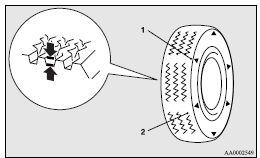Wheel condition

1- Location of the tread wear indicator
2- Tread wear indicator
Check the tyres for cuts, cracks and other damage.
Replace the tyres if there are deep cuts or cracks.
Also check each tyre for pieces of metal or pebbles.
The use of worn tyres can be very dangerous because of the greater chance of skidding or hydroplaning.
The tread depth of the tyres must exceed 1.6 mm in order for the tyres to meet the minimum requirement for use.
Tread wear indicators will appear on the surface of the tyre as the tyre wears, thereby indicating that the tyre no longer meets the minimum requirement for use. When these wear indicators appear, the tyres must be replaced with new ones.
On 4-wheel drive vehicles, when replacement of any of the tyres is necessary, replace all of them.
![]() Caution
Caution
► Always use tyres of the same size, same type, and same brand, and which
have no wear differences.
Using tyres of different size, type, brands or degree of wear, will increase the
differential oil temperature, resulting in possible damage to the driving system.
Further, the drive train will be subjected to excessive loading, possibly leading
to oil leakage, component seizure, or other serious faults.
See also:
Safety
The Insurance Institute for Highway Safety gave the Outlander Good overall
scores, the highest rating possible, in its frontal-offset and side-impact crash
tests. It received an Acceptable rating ...
Polishing
The vehicle should only be polished if the paintwork has become stained or lost
its lustre. Matt-finish parts and plastic bumpers must not be polished, polishing
these parts will stain them or dam ...
Starting and stopping the
Tips for starting
• The operation mode can be in any mode to start the engine.
• The starter motor will be turning for up to approximately 15 seconds if the
engine switch is released at once ...
